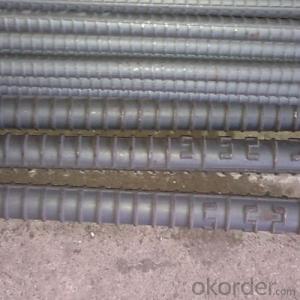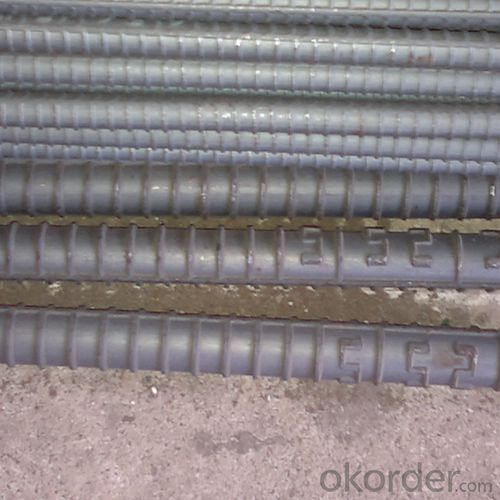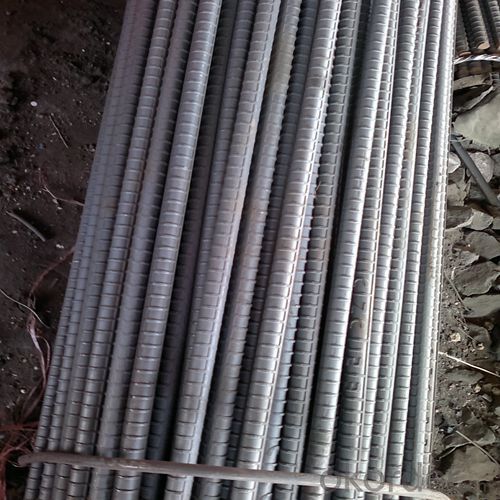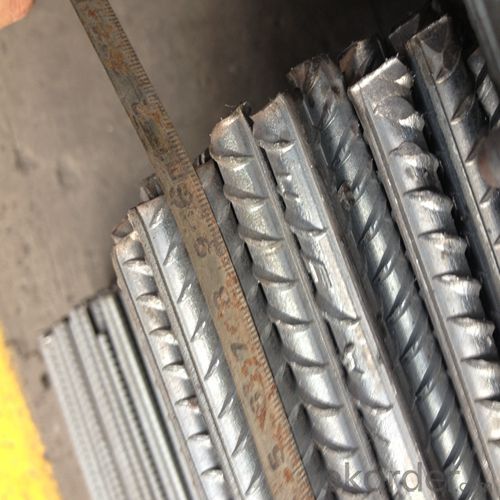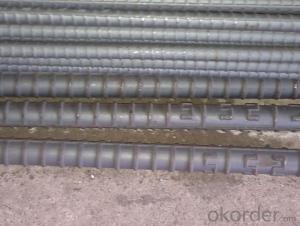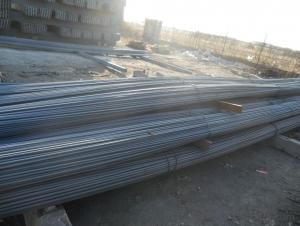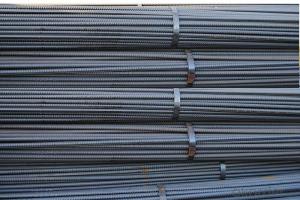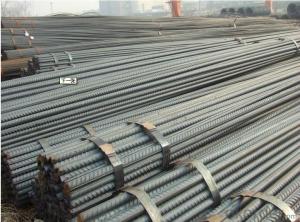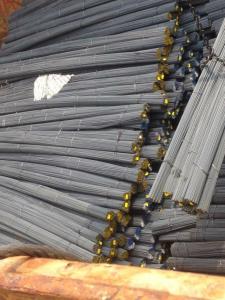STEEL REBAR HIGH QUALITY DEFORMED BAR HRB400 HRB500
- Loading Port:
- Tianjin
- Payment Terms:
- TT OR LC
- Min Order Qty:
- 200 m.t.
- Supply Capability:
- 50000 m.t./month
OKorder Service Pledge
OKorder Financial Service
You Might Also Like
Product Description:
Specifications of HRB400 Deformed Steel Bar:
Standard | GB | HRB400 | |
Diameter | 6mm,8mm,10mm,12mm,14mm,16mm,18mm,20mm, 22mm,25mm,28mm,32mm,36mm,40mm,50mm | ||
Length | 6M, 9M,12M or as required | ||
Place of origin | Hebei, China mainland | ||
Advantages | exact size, regular package, chemical and mechanical properties are stable. | ||
Type | Hot rolled deformed steel bar | ||
Brand name | DRAGON | ||
Chemical Composition: (Please kindly find our chemistry of our material based on HRB500 as below for your information)
Grade | Technical data of the original chemical composition (%) | ||||||
C | Mn | Si | S | P | V | ||
HRB400 | ≤0.25 | ≤1.60 | ≤0.80 | ≤0.045 | ≤0.045 | 0.04-0.12 | |
Physical capability | |||||||
Yield Strength (N/cm²) | Tensile Strength (N/cm²) | Elongation (%) | |||||
≥400 | ≥570 | ≥14 | |||||
Theoretical weight and section area of each diameter as below for your information:
Diameter(mm) | Section area (mm²) | Mass(kg/m) | Weight of 12m bar(kg) |
6 | 28.27 | 0.222 | 2.664 |
8 | 50.27 | 0.395 | 4.74 |
10 | 78.54 | 0.617 | 7.404 |
12 | 113.1 | 0.888 | 10.656 |
14 | 153.9 | 1.21 | 14.52 |
16 | 201.1 | 1.58 | 18.96 |
18 | 254.5 | 2.00 | 24 |
20 | 314.2 | 2.47 | 29.64 |
22 | 380.1 | 2.98 | 35.76 |
25 | 490.9 | 3.85 | 46.2 |
28 | 615.8 | 4.83 | 57.96 |
32 | 804.2 | 6.31 | 75.72 |
36 | 1018 | 7.99 | 98.88 |
40 | 1257 | 9.87 | 118.44 |
50 | 1964 | 15.42 | 185.04 |
Usage and Applications of HRB400 Deformed Steel Bar:
Deformed bar is widely used in buildings, bridges, roads and other engineering construction. Big to highways, railways, bridges, culverts, tunnels, public facilities such as flood control, dam, small to housing construction, beam, column, wall and the foundation of the plate, deformed bar is an integral structure material. With the development of world economy and the vigorous development of infrastructure construction, real estate, the demand for deformed bar will be larger and larger..
Packaging & Delivery of HRB400 Deformed Steel Bar:
Packaging Detail: products are packed in bundle and then shipped by container or bulk vessel, deformed bar is usually naked strapping delivery, when storing, please pay attention to moisture proof. The performance of rust will produce adverse effect.
Each bundle weight: 2-3MT, or as required
Payment term: TT or L/C
Delivery Detail: within 45 days after received advanced payment or LC.
Label: to be specified by customer, generally, each bundle has 1-2 labels
Trade terms: FOB, CFR, CIF
- Q: What are the common defects or issues associated with steel rebars?
- Common defects or issues associated with steel rebars include: 1. Rust: Steel rebars are prone to rusting when exposed to moisture or corrosive substances. Rust weakens the rebars, reducing their load-bearing capacity and compromising the structural integrity of the reinforced concrete. 2. Poor bonding with concrete: If the rebars are not properly cleaned or have a layer of rust, they may not bond well with the concrete. This can result in reduced strength and durability of the reinforced concrete structure. 3. Improper size or shape: Rebars that are incorrectly sized or shaped can lead to structural issues. For example, rebars that are too short or have inadequate coverage may not provide sufficient reinforcement, making the structure vulnerable to cracking or collapse. 4. Improper placement: Incorrect placement of rebars can lead to weak points in the reinforced concrete. This can occur if rebars are not adequately spaced, not aligned properly, or if there are gaps between the rebar and the concrete. 5. Improper storage and handling: Rebars should be stored in a dry and well-ventilated area to prevent rust. Improper storage or handling can result in surface damage, bending, or twisting of the rebars, affecting their performance in the reinforced concrete. 6. Welding defects: Welded rebars may have defects such as improper fusion, cracks, or lack of penetration, which can compromise the strength and integrity of the reinforcement. 7. Overlapping issues: Overlapping rebars is a common practice to ensure continuity in reinforcement. However, improper overlapping, such as insufficient overlap length or inadequate lapping of rebars, can result in weak joints and reduced structural strength. 8. Quality control issues: Inadequate quality control during the manufacturing or installation process can lead to defects or issues in rebars. This can include issues like improper chemical composition, inadequate strength, or deviations from the specified standards. It is crucial to address and rectify these defects or issues during the design, manufacturing, and construction stages to ensure the safe and reliable performance of reinforced concrete structures. Regular inspection, maintenance, and adherence to industry standards and guidelines are essential to mitigate these common issues associated with steel rebars.
- Q: Are there any specific guidelines for handling and storing steel rebars?
- Yes, there are specific guidelines for handling and storing steel rebars to ensure their quality and safety. Some of the key guidelines include: 1. Proper handling: Steel rebars should be handled with care to avoid any damage or bending. They should be lifted using appropriate equipment and not dragged or thrown. 2. Storage conditions: Rebars should be stored in a clean, dry, and well-ventilated area to prevent rusting and corrosion. They should be kept off the ground and away from moisture, chemicals, and direct sunlight. 3. Stacking: Rebars should be stacked in a way that ensures stability and prevents any deformation. They should be placed on flat surfaces and stacked in layers with wooden or rubber separators to avoid direct contact between rebars. 4. Labelling: Each bundle of rebars should be properly labeled with relevant information such as size, grade, and quantity for easy identification and inventory management. 5. Inspection: Regular inspections should be conducted to check for any signs of damage, rust, or corrosion. Damaged or corroded rebars should be discarded or repaired before use. Adhering to these guidelines is crucial to maintain the quality and integrity of steel rebars, ensuring their suitability for construction purposes.
- Q: How do steel rebars affect the constructability of a project?
- Steel rebars play a vital role in enhancing project constructability in multiple ways. To start, they offer structural strength and stability to reinforced concrete structures. By reinforcing the concrete, rebars help distribute the load more evenly, thus increasing overall project strength and durability. Additionally, steel rebars facilitate the construction of larger and taller structures. They provide the necessary tensile strength to counteract concrete's weakness in resisting tension forces. This empowers engineers and architects to design and build structures with greater flexibility, leading to more innovative and impressive architectural designs. Furthermore, steel rebars contribute to project integrity and safety. They act as a reinforcement against external forces like earthquakes, wind loads, and impacts. By resisting these forces, they enhance structural stability, thus reducing the risk of collapse or damage during extreme conditions. Moreover, steel rebars contribute to project longevity and maintenance. Thanks to their high tensile strength and corrosion resistance, they help extend the structure's lifespan. This, in turn, reduces the need for frequent repairs and replacements, resulting in cost savings and minimal disruption to the project. Additionally, the use of steel rebars simplifies the construction process. They can be easily cut, bent, and shaped to fit specific requirements, making them highly adaptable to various project needs. This flexibility allows for efficient construction, reducing time and effort required for implementation. In conclusion, steel rebars have a significant impact on project constructability by providing strength, stability, flexibility, safety, longevity, and simplification. Their use enables the construction of resilient and visually appealing structures, guaranteeing project success and sustainability.
- Q: What are the advantages of using composite steel rebars?
- There are several advantages of using composite steel rebars. Firstly, composite steel rebars offer higher tensile strength compared to traditional steel rebars, making them more durable and resistant to deformation. Secondly, they have a lower coefficient of thermal expansion, reducing the risk of cracking and improving long-term performance. Additionally, composite steel rebars are corrosion-resistant, ensuring a longer lifespan and lower maintenance costs. Furthermore, these rebars are lighter in weight, making them easier to handle and transport. Lastly, composite steel rebars can be easily fabricated and installed, allowing for greater design flexibility and faster construction.
- Q: Can steel rebars be used in the construction of road bridges or flyovers?
- Yes, steel rebars can be used in the construction of road bridges or flyovers. Steel rebars provide the necessary strength and durability required to support heavy loads and withstand the stresses and strains experienced by these structures. They are commonly used as reinforcement in concrete structures, including road bridges and flyovers, to enhance their structural integrity and ensure long-term stability.
- Q: Can steel rebars be used in seawater desalination plants?
- Steel rebars are indeed applicable in seawater desalination plants; however, careful consideration must be given to the potential impact of corrosion caused by the high salt concentration in seawater. To address this concern, several measures can be adopted. One popular approach involves employing corrosion-resistant alloys like stainless steel rebars or epoxy-coated rebars to shield against the corrosive effects of saltwater. Furthermore, regular maintenance and monitoring are essential for averting and detecting any corrosion-related problems. In conclusion, although steel rebars can be utilized in seawater desalination plants, it is imperative to incorporate corrosion protection strategies to ensure their durability and structural soundness.
- Q: What is the process of calculating the required quantity of steel rebars for a project?
- The process of calculating the required quantity of steel rebars for a project involves several key steps. Firstly, you need to determine the design requirements and specifications of the project. This includes understanding the structural drawings, plans, and any relevant building codes or regulations. Next, you need to identify the specific areas where steel rebars will be used. This can include foundations, columns, beams, slabs, and any other structural elements that require reinforcement. Once the areas are identified, you need to calculate the total length of rebars required for each element. This is done by measuring the dimensions of the elements and determining the required spacing and overlap of the rebars. After obtaining the lengths, you need to consider the bar diameter and spacing requirements, as specified in the design. This will help you calculate the number of rebars needed for each element. In addition to the length and number of rebars, you also need to consider wastage and additional reinforcement requirements. It is common practice to add a percentage of wastage (usually around 2-5%) to account for cutting and bending of the rebars. You may also need to add extra bars for special conditions or to meet the design requirements. Finally, you should create a detailed bar bending schedule (BBS) that includes all the necessary information such as bar sizes, lengths, shapes, and placement details. This schedule acts as a guide for the construction team during the installation process. It is important to note that the process of calculating the required quantity of steel rebars may vary depending on the complexity and size of the project. It is recommended to consult with a structural engineer or a professional rebar detailer to ensure accurate calculations and adherence to the project's specifications.
- Q: Can steel rebars be used in the construction of sports stadiums?
- Yes, steel rebars can be used in the construction of sports stadiums. Steel rebars are commonly used in reinforced concrete structures, including stadiums, as they provide strength and durability to the overall structure. The use of steel rebars helps to reinforce the concrete and ensure the stadium's structural integrity, making it a suitable choice for construction in sports stadiums.
- Q: Can steel rebars be used in structures with long spans?
- Yes, steel rebars can be used in structures with long spans. Steel rebars are commonly used as reinforcement in concrete structures to provide added strength and stability. They can effectively distribute tensile forces and help prevent cracks or failure in the concrete. In structures with long spans, such as bridges, high-rise buildings, or large industrial structures, steel rebars are often used to reinforce the concrete beams, slabs, and columns. This helps to ensure the structural integrity and stability of the building or structure, even under heavy loads or over long distances. Steel rebars have high tensile strength and are resistant to corrosion, making them suitable for use in long-span structures where durability and reliability are important factors.
- Q: How do steel rebars improve the structural integrity of concrete?
- The structural integrity of concrete is greatly improved by steel rebars in several ways. Firstly, they bolster the tensile strength of concrete, which is otherwise feeble in tension. While concrete excels in compressive strength, it lacks the ability to withstand pulling or stretching forces. By inserting steel rebars into the concrete, the overall tensile strength of the structure is significantly heightened. The steel rebars function as reinforcement by dispersing stress and load across a wider area, preventing cracks and fractures from spreading through the concrete. They establish a sturdy bond between the concrete and the reinforcement, enabling the structure to bear heavy loads and withstand bending, shearing, and other forces that could jeopardize its stability. Furthermore, steel rebars aid in managing and mitigating the impacts of shrinkage and thermal expansion and contraction that occur in concrete. These occurrences frequently lead to cracking and structural damage. The steel rebars help restrict the movement of the concrete, lessening the likelihood of crack formation and ensuring the overall integrity of the structure. Moreover, steel rebars prolong the durability and lifespan of concrete structures. They possess a high resistance to corrosion, which is particularly crucial in environments with elevated moisture levels, chemical exposure, or contact with saltwater. The presence of steel rebars safeguards the concrete from deterioration and extends the lifespan of the structure. In conclusion, steel rebars play a vital role in enhancing the structural integrity of concrete by fortifying its tensile strength, distributing stress and loads, preventing cracks, managing shrinkage, resisting bending and shearing forces, and increasing durability. They provide a dependable and efficient reinforcement system that guarantees the stability and longevity of concrete structures.
Send your message to us
STEEL REBAR HIGH QUALITY DEFORMED BAR HRB400 HRB500
- Loading Port:
- Tianjin
- Payment Terms:
- TT OR LC
- Min Order Qty:
- 200 m.t.
- Supply Capability:
- 50000 m.t./month
OKorder Service Pledge
OKorder Financial Service
Similar products
Hot products
Hot Searches
Related keywords
